M39 Lens Mount Rangefinder Cameras
A Description of Other M39 Lens Mount Rangefinder Cameras
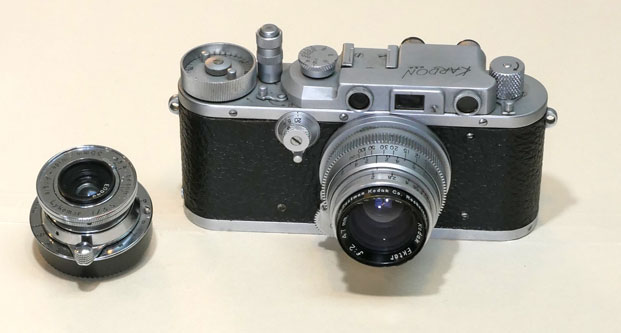
a Kardon 35mm with Kodak Ektar 47mm f2.0 and Kodak Lykemar 35mm f3.5 lens
The Kardon 35mm Rangefinder
At the outset of US war with Germany in 1941, the US government seized control of most Germany assets in the US, including the E. Leitz Company of New York. Since the US military could not purchase the leading German cameras in wartime, the Army directed E. Leitz of New York to manufacture Leica IIIa cameras. However, by 1943, it was apparent that the New York Leitz repair facility was not capable of manufacturing a Leica IIIa.
Then, Peter Kardon, a naturalized US citizen born in Odessa in the Ukraine, decided to act. He was head of the Premier Instrument Corporation, which had camera expertise. Using the Leica information in the E. Leitz New York facility, he proceeded to construct copies of Leica IIIa cameras. He found, however, that the design of the Leica IIIa was not compatible with mass production - only for hand craftsmanship of each camera. Kardon therefore embarked on designing components capable for mass production techniques. However, just when he was producing cameras in some volume, the war ended and his Army contracts were cancelled. 19
Kardon then began commercial sales to the civilian market in 1946, but his costs and therefore his selling price was not competitive with imported Japanese and Germany 35 mm cameras. A partial reprieve came from the Army in 1945, with the order of a cold weather version of his camera. This is the model shown in the photographs here. You can see the raised shutter release in the photograph below which allowed operation of the camera with gloves.
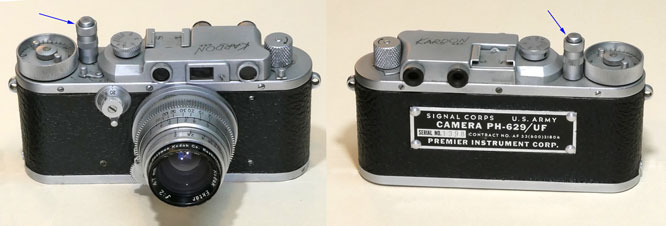
Kardon 35mm showing US Army Signal Corps identification
However, Kardon production continued to be uneconomic, and Peter Kardon died in 1948 at age 62 of complications from a stomach ulcer, likely brought on by these difficulties. Kardon camera production ceased in 1955 - an amazing story. 19
Lenses for the Kardon 35mm Rangefinder
The US Army arranged for Eastman Kodak to produce lenses which could be used with the Kardon rangefinder. The usual normal lens for the Kardon was a Kodak Ektar 47mm f2.0. Eastman Kodak also produced a Kodak Lykemar 35mm f3.5 lens, which could also be used for Army close-up photography - perhaps for copy work.
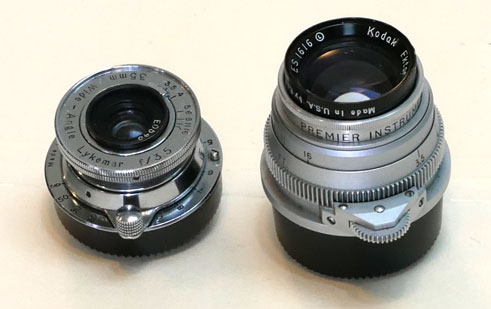
(l) Kodak Lykemar 35mm f3.5 lens and (r) the Kodak Ektar 47mm f2.0 lens
you can see the engraving "Premier Instrument Corporation" on the 47mm lens mount, indicating that Peter Kardon's company manufactured the lens mount.
Chiyotax Rangefinder Cameras
the Chiyotax IF of 1953
The Chiyotax IF was commercialized beginning late 1951 as a very low priced 35mm camera without rangefinder. The body was priced at only Yen 10,000, with a Lena Kōgaku 50mm f3.5 lens for an additional Yen 7,000. The Lena Kōgaku lens was apparently made by Reise Kōgaku - ライゼ , who also manufactured this camera sold under the Chiyotax name. The camera shown above was fitted with a Konishiroku Hexar 50mm f3.5 lens. These cameras were meticulously made in small workships.
The Chiyotax IF had no slow speed shutter dial, and the single speed dial on the camera top featured Z, 20, 30, 40, 60, 100, 200, 500 speeds. The camera pictured had flash synchronization, although earier production beginning 1951 was without synchronization.
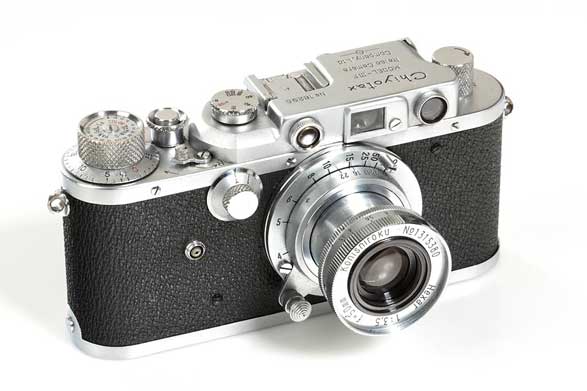
the Chiyotax IIIF of 1955
The Chiyotax cameras were Leica copies, made in the mid-1950s by Reise Camera Co. Ltd. - ライゼ for the distributor Chiyoda Shōkai. The name Chiyoca is a contraction of Chiyoda Camera. In 1957, the Reise company ended operations, and its manager and workers was hired by Misuzu Kōgaku Kōgyō, and continued the production of Leica copies under the name "Alta".
The Chiyotax IIIF was introduced in 1955 at the very low price of Yen 29,800 fitted with with the Konishiroku Hexar 50mm f3.5 lens. Like the Leica IIIf, the Chiyotax cameras used a detachable bottom plate for film loading. The dual dials were split at 1/20 second with a top speed of 1/500 second. The viewfinder had a diopter adjustment. One coaxial flash connection was on the camera front, but initially only for flash bulb synchronization. Later, synchronization for electronic flash was added, with a "F/X" switch on the camera front and the flash connection moved to the camera back.
The Alta Rangefinder Camera
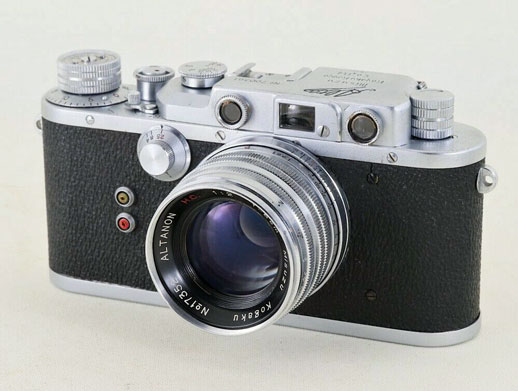
the Alta rangefinder
The Alta (アルタ) was a Leica copy, made during 1957 and 1958 by Misuzu Kōgaku Kōgyō by technicians who had made the Chiyotax cameras. The camera top was labelled "Alta" and "Misuzu Kogaku Kogyo Co., Ltd."
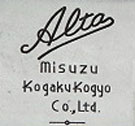
Film loading was via a bottom plate such as the Leica IIIf. There are two flash synchronization sockets on the camera front.
Introduced in October 1957, the Alta was promoted by Misuzu Kōgaku Kōgyō at the very low price of Yen 35,000. This pricing seems to have been the principal promotional aspect.
The Corfield Periflex
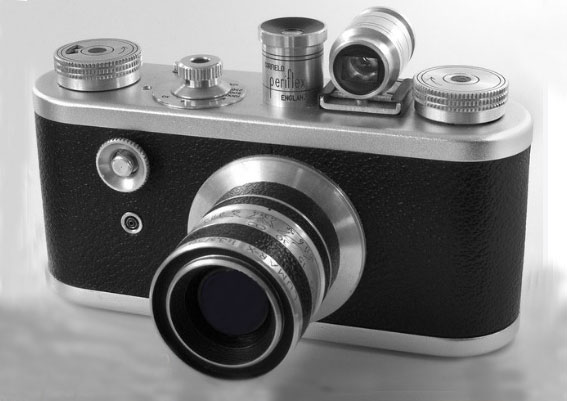
Corfield Periflex of 1955
The Corfield Periflex was introduced in 1953 by K. G. Corfield Ltd. of the West Midlands, England. It couples with an M39 screw mount lens, which in the Corfield Periflex case was a Corfield Lumar 50mm f3.5 lens. This lens was assembled by Corfield from lenses supplied by the British Optical Lens Company. 22
The Corfield Periflex provides through-the-lens focusing using an inverted periscope which was lowered into the light path between the lens and the film plane. This was somewhat similar to the later single-lens reflex principle. This periscope shows a small section of the center of the image to facilitate focusing.
The periscope was raised and lowered by a knob on the side of the periscope as marked by the arrow in the photograph below. There was also an accessory shoe which included a conventional viewfinder.
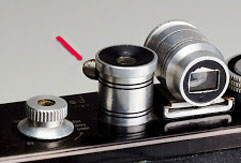
It has a single knob shutter speed controlling a focal plane shutter with 1/30 to 1/1000 second. The Corfield Periflex proved reasonably popular and continued to be produced until 1960.
The Foca Camera
The Foca camera was developed by Société Optique et Précision de Levallois, S.A. (OPL) in 1938-1939, but was delayed in production by World War II. A small number of cameras without serial numbers was produced in 1945 labeled with the simple label "Foca". This is usually refered to as the "Foca PF2".
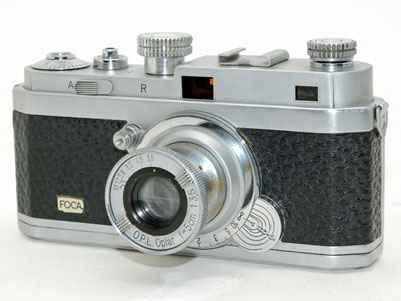
Foca PF2 camera of 1945
This camera featured a Oplar 5cm f3.5 lens. Some models had two flash synchronization connections, perhaps added after manufacture. Serial numbers began 25xxx.
Foca 1 Star
The early Foca camera described here, the "Foca 1 Star" was introduced in 1945.
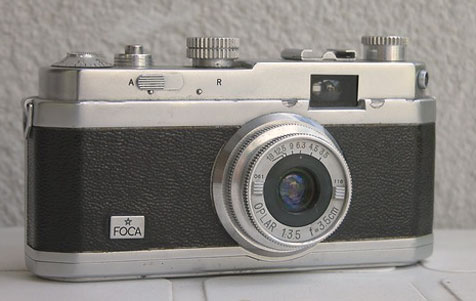
Foca 1 Star camera of 1945
The Foca 1 Star camera was built Octobre 1945 until the end of 1946. The viewfinder had a yellow tint. It had fast speeds only: B, 20, 30, 50, 100, 200, 500. The usual lens was labelled as Foca 5cm f3.5 without serial number.
The Foca 1 Star was labeled with "☆ Foca"
Foca 2 Star Camera

Foca 2 Star camera of 1947
The Foca was labeled with two stars "☆ ☆ Foca". These cameras had focal plane shutters and the M39 screw mount lenses. It was sold with a Oplar 5cm f3.5 lens. Later, a Oplarex 50mm f1.9 collapsible barrel lens was offered. There was an integration of viewfinder and rangefinder.
The camera was initially launched without coupled rangefinder, and with M39 screw mount lens. It was later produced with a conventional rangefinder. Also flash bulb and electronic flash synchronization was added. In 1961, the Foca viewfinder became wider with 1:1 magnification and parallax corrected. Production of this camera ended in 1965. A verson of this camera using a bayonet lens mounting was also developed.
Foca 3 Star Camera
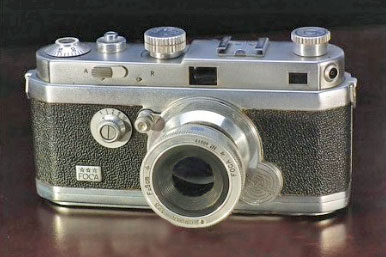
Foca 3 Star camera of 1947
The Foca 3 Star camera was produce in 1200 untis between 1947 and 1951. It was labeled "☆ ☆ ☆ Foca". It had both high speed and low speed dials: 1, 2, 4, 8, 20 and B, 1-20, 30, 50, 100, 200, 500.
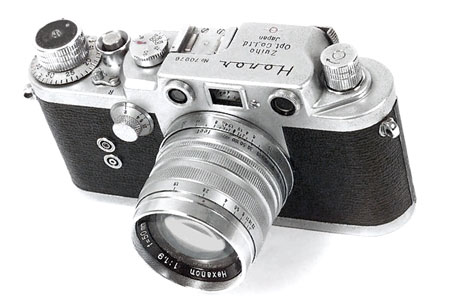
Honor S1 of 1958 with 50mm Hexanon f1.8 lens
The Honor S1 was produced from 1956 to 1959, initially by Mejiro Kōgaku, and later by Zuihō Kōgaku. Its appearance is similar to the Leica IIIf. The viewfinder and rangefinder are separate, with the viewfinder having a diopter adjustment. It had high and slow shutter speed dials split at 1/25 second with a top speed of 1/500 second.
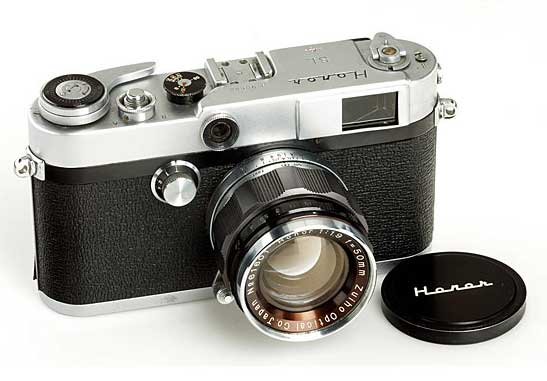
Honor SL of 1960 with 50mm Zuiho Optical f1.9 lens
The Honor SL was announced in December 1959, and started to ship in 1960. Serial numbers seem to have been from 90001 to 90695, with perhaps somewhat less than 700 bodies produced. "Zuiho Opt. Co., Ltd. Japan" is engraved on the back cover to the right of the viewfinder. 1960 was a late year for a 35mm rangefinder camera, particularly one such as this with features several years out of date - such as split shutter speed dials, and a viewfinder without automatic parallax correction.
Melcon Rangefinder Cameras

Melcon I with Nikkor H 5cm f2.0 lens
Melcon 35mm rangefinder cameras were manufactured by Meguro Kōgaku Co. Ltd. - 目黒光学株式会社 . The Melcon was a Leica copy made from 1955 to 1957 by Meguro Kōgaku Kōgyō and distributed by the Hinomaruya company - ひのまるや. It was a close copy of the Leica IIIc. It had split lens speed dials with slow speeds of T, 1, 2, 5, 10, 25 and fast speeds dials of B, 25–1, X , 50, 75, 100, 200, 500. The X speed was synchronized at 1/40 second. The flash socket was placed on the camera front. The viewfinder did not feature parallax correction.
The camera developer was Yashima Shōhei - 矢島庄平 in 1956. He emphasized the manufacturing tolerances and resistance to high and low temperatures. It seems that Nippon Kōgaku performed some level of quality control.
The camera was distributed by Zuihō Kōgaku Seiki.
The usual lens fitted to the camera was the Nikkor H 5.0 cm f2.0.
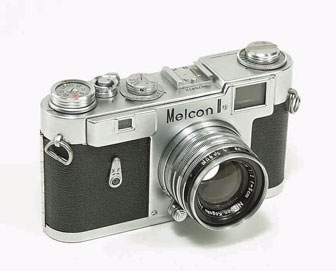
Melcon II with Nikkor H 5cm f2.0 lens
The Melcon II had slow and fast shutter speed dials on the camera top with slow speed dial settings of T, 1, 2, 5, 10, 25, and fast dial settings of B, 25–1, X, 50, 75, 100, 200, 500. The X synchronization speed was 1/40 second. The rangefinder had a long base at 70mm.
There is a single flash synchronization connection on the camera front and is selected by a F/X switch. The combined viewfiner-rangefinder was large, looking somewhat like a Nikon S2, with a diopter adjustment, but without parallax correction. It featured a switch on the camera front to select between X and F flash synchronization.
Melcon cameras featured Nikkor screw-mount lenses, and some publications state that there was a relationship between Meguro Kōgaku, Nikon, and the Hinomaruya company. The Hinomaruya company - ひのまるや was the distributor not only of Melcon cameras, as well as of Nikon optics. It had earlier been the primary distributor of Nicca cameras.
Tanack Rangefinder Cameras
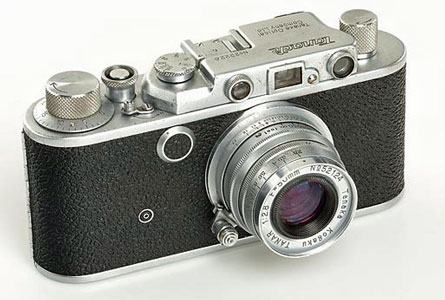
Tanack IIc with Tanar 50mm f2.8 lens in a rigid barrel; none of the f2.8 lenses were collapsible.
Tanack rangefinder cameras were made by Tanaka Kōgaku beginning 1953. First introduced, the Tanack IIc was produced as a low-priced camera, amazingly selling for a very low Yen 23,800 with a collapsible Tanar 50mm f3.5 lens. This lens was a 4 element in 3 groups Tessar design.
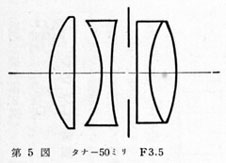
scheme of the Tanar 50mm f3.5 lens of 1953
The Tanack IIc camera had fast speeds only, with speeds of B, 20, 30, 60, 100, 200, 500. It had flash bulb synchronization. No model number was engraved on the camera top. The viewfinder was without any diopter adjustment.
During the early 1950s, Tanaka Kōgaku introduced a four different models of this camera, all at very low prices. The 50mm f2.8 Tanar lens versions were introduced in Spring 1954: 21
- IIC without slow speeds with 50mm f3.5 Tanar lens Yen 23,800
- IIIC without slow speeds with 50mm f2.8 Tanar lens Yen 26,400
- IIF with slow speeds with 50mm f3.5 Tanar lens Yen 27,200
- IIIF with slow speeds with 50mm f2.8 Tanar lens Yen 29,800
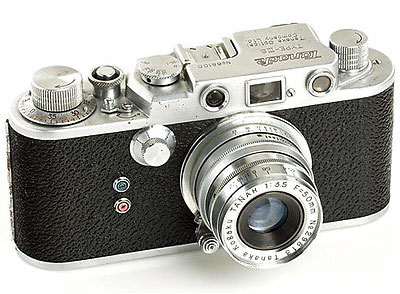
Tanack Type IIIS with Tanar 50mm f3.5 lens
The Tanack IIIS was introduced in late 1954. It had dual shutter speed dials at B, 25–1, 50, 75, 100, 200, 500 and T, B, 1, 2, 4, 8, 25 on the slow speed dial. Note that the slow speed dial lacked a 1/15 or 1/20 second speed. The camera has flash synchronization with two connection sockets for flash bulb and X electronic flash respectively.
Again, launched this camera at very low prices. The Tanack 35 IIIS sold for Yen 31,700 with the Tanar 50mm f2.8 lens, and Yen 29,100 with the rigid Tanar 50mm f3.5. Camera bodies had serial numbers in the 68xxx range, and probably less than 1000 units were produced. The model name "TYPE–IIIS" is engraved above the viewfinder, between the brand name "Tanack" and "Tanaka Kōgaku".
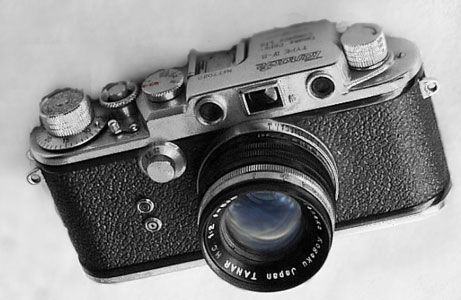
Tanack Type IV-S with Tanar 50mm f2.0 lens
The Tanack IV-S was introduced in 1955. On introduction, the camera continued to be low priced. It was only Yen 38,500 with the 50mm f2.0 Tanar lens, and Yen 31,700 with a 50mm f2.8 Tanar and Yen 29,100 with a 50mm f3.5 Tanar lens. Later versions of the f2.0 and f2.8 lenses were changed from a chrome body to black and chrome in 1957. The f3.5 Tanar remained in a chrome on brass finish.
Serial numbers began at about 685xx, and approximate 11,000 units were produced. Later models had a colored film reminder on top of the advance knob. The Tanack Type IV-S was succeeded by the Tanack V3 in January 1959.

Tanack V3 with Tanar 5cm f1.9 lens
The Tanack V3 was introduced in 1959 by Tanaka Kōgaku. It featured a combined rangefinder-viewfinder. With a viewfinder magnification of 1:1 allowing keeping both eyes open during photographing, but without parallax correction.
This was the first Tanack camera with lever film advance. It has a full opening back. A major innovation was the adoption of a lens mount being a three-lug bayonet mount. However, Tanaka Kōgaku did not introduce any lens in this bayonet mount. Instead, they offered a Tanar 5cm f1.9 lens in a M39 screw mount in an adaptor ring, as shown below.
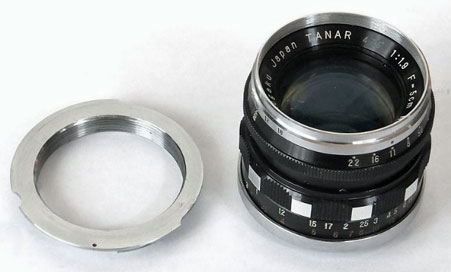
In addition to the Tanar 5cm f1.9 lens, the camera was offered with a rigid Tanar 5cm f2.8 lens.
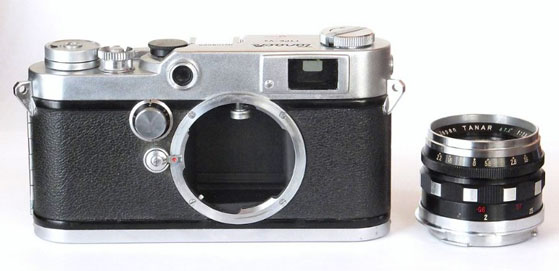
Tanack V3 with Tanar 5cm f1.9 lens inserted into lens adaptor ring
| Navigation: Click Below to Jump to Desired Subject Page | ||
|---|---|---|
| Canon Rangefinder Cameras - 1 | Canon Rangefinder Cameras - 2 | Canon Rangefinder Lenses |
| Canon Hansa | Canon IIAF, IIAX | Development Nikkor 50mm |
| Canon S | Canon IVSB2 | Canon 19mm |
| Canon J | Canon IIS2, IID2, IIF2 | Canon 25mm |
| Canon NS | Canon VT, Canon L2 | Canon 28mm |
| Canon JS | Canon L1, L3 | Canon 35mm |
| Canon S-I | Canon VT Deluxe | Canon 50mm |
| Canon J-II | Canon VL, VL2 | Canon 85mm |
| Canon S-II | Canon VI-L, VI-T | Canon 100mm |
| Canon IIB | Canon P | Canon 135mm |
| Canon III, IIC, IV | Canon 7 | Canon 200mm-1000mm |
| Canon IIIA, IVF, IVS | Canon 7s | Canon Accessories |
| Canon IIA, IID, IID1 | Nicca Rangefinders | Canon Finders |
| Canon IVSB | Minolta Rangefinders | Minolta Lenses |
| Canon IIF, IIS | Other Rangefinders | other M39 lenses |
| Go to canonrangefinder.com home page | ||
Any additions or corrections to these pages would be welcome simply by contacting this site as shown at the foot of this page .
Footnotes:
1 Dechert, Peter. Canon Rangefinder Cameras 1933-1968. Hove Collectors Books. West Sussex, United Kingdom. 1985. ISBN 0-906447-30-5.
Peter Dechert's book is the most important expert source of information regarding Canon Rangefinder Cameras.
2 Kitchingman, Peter. Canon M39 Rangefinder Lenses 1939-1971. A Collector's Guide. Published by Peter Kitchingman. Perth, Australia. 2008. ISBN 978-0-646-48144-9.
Peter Kitchingman's book is the definitive study of the more than three decades of M39 format camera lenses developed for Canon Rangefinder Cameras.
3 Nostalgic Canon Camera Book. 懐かしいキヤノン EI Publishing Co. Ltd. Tokyo, Japan. June 2003.
Peter Kitchingman's book is the definitive study of the more than three decades of M39 format camera lenses developed for Canon Rangefinder Cameras.
4 "Canon Camera Museum" history website. https://global.canon/en/c-museum/history/ published by Canon, Inc. accessed in 2019.
5 Rajner, Hans P. (author), John Wade (editor). Leica Copies. Classic Collections Publications. London, UK. ISBN 13: 9781874485056
Hans P. Rajner's book is an excellently detailed and carefully researched study of camera from around the world which used the Leica M39 lens mount and the same lens to film plane distance.
7 Dechert, Peter. Canon Single Lens Reflex Cameras 1959-1991. Historical Camera Publications. Yakima, Washington. 1992. ISBN 1-879561-04-2.
8 Tomlinson, Shawn M. The Film Photography Book. Lulu Pulbications. 2016. ISBN: 9781365263972
9 Sartorius., Ghester. Identifying Leica Lenses. Classic Camera 19. Tokyo, Japan. 2001. ISBN 4-257-12029-0
10 website http://www.nicovandijk.net/rflensmatrix.htm consulted 2019.
11 O'Reagan, Douglas M. Allied Exploitation of German Science after World War II. Johns Hopkins University Press. Baltimore, Maryland. 2019. ISBN 9781421428888
12 website www.canonrangefinder.servehttp.com consulted 2008.
13 Minolta expert Andrea Aprà has posted information on minoltarangefinders group and other groups and further detailed information by email. (thanks Andrea !)
14 website http://www.collection-appareils.fr/objectifs/ consulted 2019.
15 Small, Marc James. Non-Leitz Leica Thread-Mount Lenses. Wittig Books. Hückelhoven, Germany. 1997. ISBN 3-930359-47-2.
16 the Nikon Corporation website: https://imaging.nikon.com/history/ consulted 2019.
17 p 152. Ray, Sidney F. Photographic Lens ISBN 9780240510323
18 website http://www.rokkorfiles.com/Lens%20History.html accessed 2019
19 Katz, Jerome. The Kardon camera story: a dedication to Peter Kardon, great American patriot & pioneer. SJF Enterprises. New York, New York. 1977.
20 Dominique and Jean-Paul Francesch. Histoire de l'Appareil Photographique Minolta Dessain et Toira. Paris. 1985.
21 Asahi Camera.; Tokyo March 1954, February 1955.
22 P. H. van Hasbroeck. 150 Classic Cameras Sotherby's Publications. London. 1989.
If you have any comments or questions about this Canon Rangefinder site, please e-mail me (Larry Huffman) at e-mail address: [email protected]